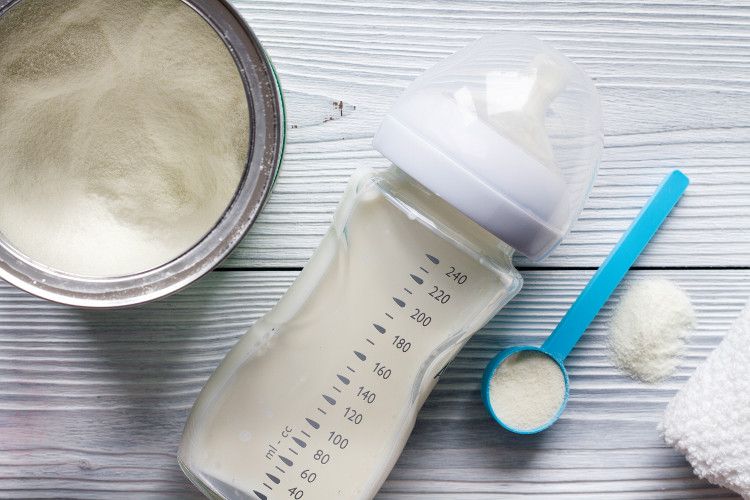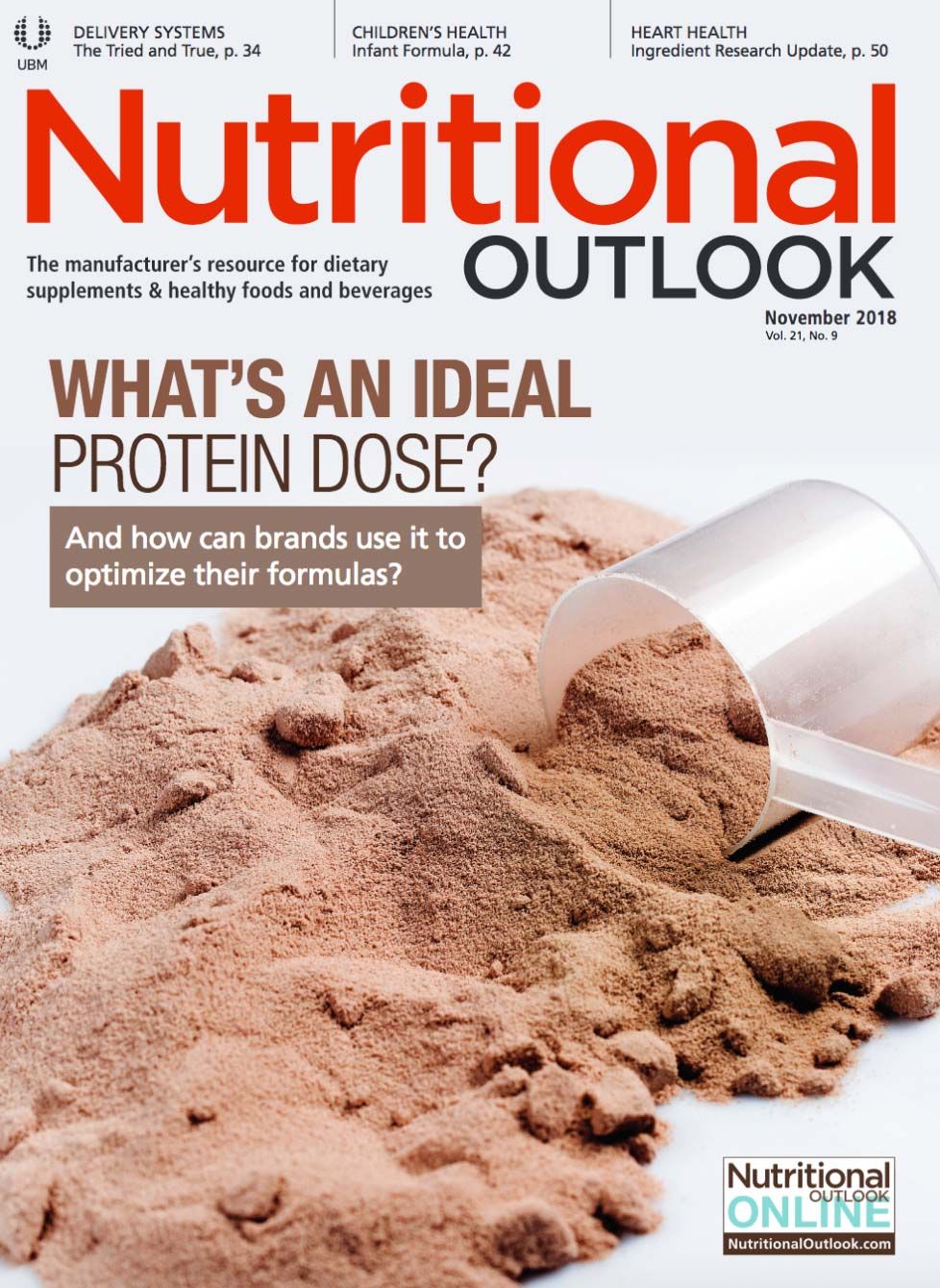Infant formula ingredients try to bridge the breastmilk gap
Infant formula brands have to ramp up the innovation to build a product that delivers what’s best for baby-which nowadays means what comes closest to the breastmilk ideal.
Photo © 279photo - Stock.adobe.com.

Few formulation challenges are more sensitive than designing a safe and wholesome infant formula. After all, this is one audience that depends on us completely to get things right.
And as competition among brands heats up-with the stiffest competition coming from the breast itself-savvy parents increasingly, and justifiably, scrutinize everything they feed their littlest family members, holding infant formulas to the strictest standards of all.
So now that “safe and wholesome” alone no longer cut it, infant formula brands have to ramp up the innovation to build a product that delivers what’s best for baby-which nowadays means what comes closest to the breastmilk ideal.
None of which surprises Sigalit Zchut, PhD, chief scientist, Advanced Lipids, a joint venture of lipids companies AAK (Malmo, Sweden) and Enzymotec (Migdal HaEmeq, Israel). “Consumers naturally want the best for their kids,” she says. “Yes, quality has always been the number-one consideration when it comes to infant formula, but more often it’s not just about quality, but about quality plus specific nutritional benefits.” Benefits that bridge the breastmilk gap.
Going Global
It’s no secret that sales of infant and baby nutrition products have trended flat in wealthy countries as women have embraced breastfeeding. But it’s a big world out there, and the global market for infant formula has almost tripled since 2006, Zchut says, currently boasting a retail value of over $45 billion.
China alone accounts for almost half this value, making it the world’s largest infant formula market by far. “But we’re also seeing interesting developments in other regions,” Zchut observes. “In Latin America, for example, the market is currently worth around $2.2 billion, or 150,000 metric tons in volume, and significant growth is forecast, so it’s promising territory for formula companies.”
Baseline Formula
Regardless of the region a brand targets, the baseline goal in developing any infant formula is to create a product that’s safe beyond a doubt, and that provides the nutrients essential for an infant’s optimal development.
Meeting that goal starts with the composition of the base powder, which supplies the formula’s protein and carbohydrate fractions, at 10%-15% and 52%-57% of the total formulation, respectively. “These fractions usually come from whole milk or a combination of skim milk and whey protein,” Zchut explains.
As for the fat fraction-which typically clocks in at 22%-28% of the finished formula base-“it’s mostly sourced from vegetable oils, but sometimes partially from milkfat,” Zchut continues.
Last but not least are the vitamins, minerals, and other micronutrients that bring a formula closer to nutritional completion. Though their relative proportion in the finished product is low-roughly 4%-6%, in total-“they’re just as crucial for the baby’s healthy development” as the formula’s other components, Zchut insists.
Setting Standards
Currently, the nutrient content of infant formulas sold domestically falls under FDA purview and is based on recommendations from the American Academy of Pediatrics Committee on Nutrition.
Present guidelines deem that all formulas made in the United States must contain protein, carbohydrates, fat, and linoleic acid. All formulas must also include vitamins A, C, D, E, K, thiamin (B1), riboflavin (B2), niacin (B3), pantothenic acid (B5), pyroxidine (B6), folic acid (B9), and cyanocobalamin (B12). Calcium, magnesium, iron, zinc, manganese, copper, phosphorus, and iodine are also required, as are the electrolytes sodium chloride and potassium chloride and some of the nucleotides found naturally in human breastmilk, like uridine, inosine, and cytidine.
Regulatory tightening has improved formula compositions over the years, with one key change tracing back to the nutrient requirements specified in the Infant Formula Act of 1980, passed in response to a 1979 recall of chloride-deficient formulas that sickened thousands of infants and yielded enough lawsuits to get the regulations changed.
Breast Is Best
But even with enhanced regulatory oversight and the laundry list of required nutrients, infant formulas don’t match the composition or nutritional potency of human breastmilk, which, Zchut concedes, “is the gold standard toward which every formula brand should strive. It provides the optimal nutrition for infants, delivering a perfect balance of nutrients that naturally meets every need in the first months of life.”
But, notes Steen Lyck, global business director for HMO, DuPont Nutrition & Health (Madison, WI), “Human breastmilk is very complex, and it’s impossible to mimic its composition.”
Zchut agrees. “Human milk contains a lot of biological components that are impossible to copy, such as immunoglobulins-antibodies produced by the mother to protect the infant from infections in early life,” she points out. Breastmilk is also always changing. “Its composition in the day after birth is different from its composition when the baby’s one, three, or six months old,” Zchut continues. “All that is very difficult to copy, and there are many more differences to count.”
Closing the Gap
Yet despite the head start that millennia of evolution gave us in fine-tuning the nutritional perfection that is breastmilk, the infant nutrition industry has to work within the span of a product cycle. Even so, it’s making genuine strides in closing the gap between mom’s product and its own.
“Infant formula has improved significantly over the past two decades thanks to scientific research that studies human milk composition on one hand, and clinical studies that test the effect of key ingredients on the wellbeing of the baby on the other,” Zchut says.
Structured Fats
The result is the addition of “specialty” ingredients to formulas that wouldn’t have appeared there even a few years ago. Consider the industry’s efforts better to replicate the unique lipid structure of breastmilk. Most of the palmitic acid in human milk fat is attached to the central carbon in the fat’s glycerol backbone. SN2 palmitate or OPO (oleic and palmitic fatty acid structure) is a structured triglyceride that mimics this conformation, and, says Zchut, “We can now develop OPO from vegetable sources and offer it as an ingredient in formulas. By mimicking the fatty acid positioning of human milk, it delivers many of the same benefits.”
A recent clinical trial involving INFAT, her company’s branded OPO ingredient, found that it enhanced fatty acid absorption to more closely resemble breastfeeding, she says. “Research also shows that it offers benefits for comfort, healthy growth, and immunity.”
Beneficial Oligosaccharides
Human milk oligosaccharides, or HMO, comprise another class of ingredients finding their way into infant formulas. These are a collection of indigestible short-chain carbohydrates-glucose, galactose, fucose, sialic acid, and N-acetyl-glucosamine among them-with pre-clinically and clinically validated benefits for infants.
“Some of their healthful effects include promoting a Bifidobacteria-rich microbiome, creation of the building blocks for brain development, prevention of pathogens and viruses, and stimulation of the immune system,” says DuPont Nutrition & Health’s Lyck. “By introducing commercially produced HMO that are structurally identical to those found in breastmilk, we can narrow the gap between human milk and formula.”
Granted, while human breastmilk contains hundreds of HMO, “We’re only introducing a few” in commercial formulas, Lyck concedes. “So there’s still a long way to go.” And the optimal levels at which to add them are still up for discussion.
For example, the most abundant HMO in human breastmilk, appearing on average at 2.4 g/L, is 2’fucosyllactose (2’-FL). “But this varies a lot from woman to woman, region to region, and where the mother is in the lactation period,” Lyck explains. And while 2.4 g/L is the HMO addition level that FDA regulations approve in infant formulas, the EU approves only half that amount, basing its decision on the few infant clinical studies carried out so far.
In 2016, two companies, DuPont and Inbiose (Ghent, Belgium), entered into a joint development and licensing agreement for the exclusive rights to produce and commercialize a 2’-FL ingredient that is “fully identical to the 2’-FL HMO found in human milk.” The companies announced the ingredient had been granted EU Novel Food regulatory approval for infant formulas in December 2017 and U.S. Generally Recognized as Safe (GRAS) status in April 2018.
In May, another company, FrieslandCampina Domo (Amersfoort, The Netherlands), announced its new 2’-FL ingredient received EU Novel Food approval and GRAS status in the U.S. In 2016, FrieslandCampina Domo partnered with U.S.-based carbohydrates firm Glycosyn to develop a range of infant nutrition ingredients. FrieslandCampina Domo says that this new 2’-FL ingredient will be the first in a range of HMOs that the companies are developing. The company also says that it is currently building a new manufacturing plant in Italy dedicated to large-scale production of 2’-FL HMOs, which is slated for completion by the end of the year. The new 2’-FL ingredient will be marketed under the brand name Aequival.
Critical Membranes
Because the fat source used in most infant formulas are plant-derived oils, they lack an important tri-layered protein and lipid structure that encases every milk fat globule found in human, as well as bovine, milk. This membranous structure, known as milk fat globule membrane (MFGM), is also rich in bioactive gangliosides, phospholipids, glycolipids, glycoproteins, and carbohydrates with demonstrated benefits for an infant’s brain development, gut health, nutrient absorption, and immune function.
A 2017 review1 of studies examining the effects of adding MFGM to infant formulas concluded, “Available evidence from model studies and clinical trials indicates the potential of beneficial effects of the combination of bioactive compounds or any specific component of MFGM to improve infant formulas. Importantly this relates to actual health during infancy and may contribute to optimizing the long-term programming of the immune system and cognitive functions.”
While the researchers called for more study before implementing widespread addition of MFGM to infant formulas, they do note, “The availability of some corresponding components from bovine milk or biotechnological production offers the possibility to include these components into formulas and to further close the gap between formula-feeding and breast-feeding.” Something to keep your eye on for the future.
Building Baby’s Microbiome
As Lyck notes, “Infant-specific probiotics have been added to formula to mimic the microbiome that’s transferred from mother to baby during birth and breastfeeding.” And given the excitement surrounding their potential benefits for the broader public, curiosity about how they might help improve infants’ prospects seems like a logical extension.
Indeed, says John Quilter, vice president and general manager, GanedenBC30 and Wellmune, Kerry (Beloit, WI), “Currently, three out of four U.S. consumers are aware of probiotics. As this awareness continues to grow both in the U.S. and globally, probiotics as an ingredient in infant formulas may become more commonplace.”
And for good reason: “There are a variety of factors that can negatively affect the natural bacteria and digestive development of infants and toddlers,” Quilter explains. “Furthermore, babies are born with sterile digestive tracts and must work to build their beneficial gut bacteria and create a healthy microbiome.” Evidence suggests that probiotics can help.
His company’s GanedenBC30 (Bacillus coagulans GBI-30, 6086) probiotic has scientific support for its digestive and immune benefits and, as a spore-former, “has a natural, protective shell that allows it to remain dormant through most manufacturing processes and gastric transit, and has a three-year shelf life, making it an excellent choice for powdered infant and toddler formulas,” Quilter says. Just as impressive, in 2017 it was the first B. coagulans probiotic to receive FDA GRAS status for use in infant formula.
Jumping through Hoops
That matter of FDA go-ahead is no small consideration for formula manufacturers, and understandably so. “The regulation of infant formula is very rigorous because it’s the sole source of food for the newborn infant and is therefore an extremely sensitive type of food,” Zchut says. “It undergoes much more rigorous review by regulatory authorities than does food for adults.”
Because regulations differ globally, how long it takes to get new ingredients approved varies, but you’re almost always looking at an expensive process that unfolds over a years-long horizon-“in some countries one to two years, and in others closer to five,” Lyck says. “This includes developing and documenting safety data, maybe clinical studies, documentation of a constant and safe process-all of this collected in a dossier and followed by approval of the dossier and publication.”
But the trouble is worth it to start Junior out on the right footing. As Lyck says, “We know that the first 100 to 1,000 days in a baby’s life determine so many health aspects later in life, as well.”
References:
- Hans D et al. “Benefits of lactoferrin, osteopontin and milk fat globule membranes for infants.” Nutrients, vol. 9, no. 8 (July 28, 2017): 817

Prinova acquires Aplinova to further increase its footprint in Latin America
April 7th 2025Prinova has recently announced the acquisition of Brazilian ingredients distributor Aplinova, which is a provider of specialty ingredients for a range of market segments that include food, beverage, supplements, and personal care.

















